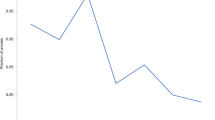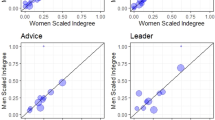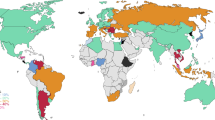Abstract
In Australian astronomy, women’s representation remains at historic lows, despite a decade of initiatives aimed at improving the representation and support of women in astronomy and academia more generally. Drawing from research in the fields of sociology and psychology, we designed a new evidence-based programme to increase the percentage of women recruited and retained in astronomy. We applied identical recruitment methods to 47 fixed-term postdoctoral positions across nine universities from 2017 to 2022 within the ARC Centre of Excellence for All Sky Astrophysics in 3 Dimensions (ASTRO 3D). Through this method, ASTRO 3D achieved 50% women personnel in five years, including 56% women postdocs and 52% women students recruited. A tipping point was reached at 40% women overall, after which women students enrolled in the centre in accelerating numbers. Evidence-based retention initiatives were highly successful, yielding greater retention of women than men. The percentage of women in teams correlated strongly with the team lead gender, highlighting the importance of diverse team leadership. This work presents a clear pathway for organizations to achieve and retain gender diversity within postdoctoral and student cohorts without quotas.
This is a preview of subscription content, access via your institution
Access options
Access Nature and 54 other Nature Portfolio journals
Get Nature+, our best-value online-access subscription
$29.99 / 30 days
cancel any time
Subscribe to this journal
Receive 12 digital issues and online access to articles
$119.00 per year
only $9.92 per issue
Buy this article
- Purchase on Springer Link
- Instant access to full article PDF
Prices may be subject to local taxes which are calculated during checkout




Similar content being viewed by others
Data availability
The data that support the figures within this paper and other findings of this study are part of the ASTRO 3D membership database available from https://astro3d.org.au/membership/find-a-member/. The change in membership and fraction of women in ASTRO 3D over time is in the ASTRO 3D annual reports publicly available from https://astro3d.org.au/annual-reports/. The ASTRO 3D hiring guidelines and the ASTRO 3D equity and inclusion action plan are available at https://astro3d.org.au/diversity/astro-3d-equity-and-diversity-resources/. Aggregate, non-confidential data may be available from the corresponding author upon request if approved by the ASTRO 3D Executive Committee.
References
Whitelegg, E., Hodgson, B. K., Scanlon, E. & Donovan, C. Young women’s perceptions and experiences of becoming a research physicist. In Proc. 12th International Conference of Women Engineers and Scientists paper 167, (The Open University, 2002).
Miller, D. I., Eagly, A. H. & Linn, M. C. Women’s representation in science predicts national gender–science stereotypes: evidence from 66 nations. J. Educ. Psychol. 107, 631–644 (2015).
Guarino, C. M. & Borden, V. Faculty service loads and gender: are women taking care of the academic family? Res. High. Educ. 58, 672–694 (2017).
Hanasono, L. K. et al. Secret service: revealing gender biases in the visibility and value of faculty service. J. Divers. High. Educ. 12, 85–98 (2019).
Crabtree, S. A. & Shiel, C. ‘Playing Mother’: channeled careers and the construction of gender in academia. SAGE Open https://doi.org/10.1177/2158244019876285 (2019).
Wyithe, S., Asplund, M., Bok, D., Kewley, L. & Staveley-Smith, L. Decadal Plan for Australian Astronomy 2016–2025 https://www.science.org.au/supporting-science/science-sector-analysis/reports-and-publications/decadal-plan-australian-astronomy-2016-25 (Australian Academy of Science National Committee for Astronomy, 2016).
Staveley-Smith, L., Davis, T. A. M., Karakas, A., Tinney, C. & Trott, C. Decadal Plan for Australian Astronomy 2016–2025 Mid-Term Review https://www.science.org.au/supporting-science/science-policy-and-analysis/decadal-plans-science/decadal-plan-australian-astronomy-2016-25-mid-term-review (Australian Academy of Science National Committee for Astronomy, 2019).
Kewley, L. J. Diversity in Australian Astronomy. Nat. Astron. 3, 1067–1074 (2019).
Kewley, L. J. Closing the gender gap in the Australian astronomy workforce. Nat. Astron. 5, 615–620 (2021).
Konrad, A. M. & Pfeffer, J. Understanding the hiring of women and minorities in educational institutions. Sociol. Educ. 64, 141–157 (1991).
Miner, K. N., January, S. C., Dray, K. K. & Carter-Sowell, A. R. Is it always this cold? Chilly interpersonal climates as a barrier to the well-being of early-career women faculty in STEM. Equal. Divers. Incl. 38, 226–245 (2019).
Gibson, D. E. & Lawrence, B. S. Women’s and men’s career referents: how gender composition and comparison level shape career expectations. Organ. Sci. 21, 1159–1175 (2010).
McGinn, K. L. & Milkman, K. L. Looking up and looking out: career mobility effects of demographic similarity among professionals. Organ. Sci. 24, 1041–1060 (2013).
Kanter, R. M. Some effects of proportions on group life: skewed sex ratios and responses to token women. Am. J. Sociol. 82, 965- 990 (1977).
Barthelemy, R. S., McCormick, M. & Henderson, C. Gender discrimination in physics and astronomy: graduate student experiences of sexism and gender microaggressions. Phys. Rev. Phys. Educ. Res. 12, 020119 (2016).
Bossler, M., Mosthaf, A. & Schank, T. Are female managers more likely to hire more female managers? Evidence from Germany. ILR Rev. 73, 676–704 (2020).
Gagliarducci, S. & Paserman, M. D. in Gender Convergence in the Labor Market (eds Polachek, S. W. et al.) 343–375 (Research in Labor Economics Vol. 41, Emerald, 2015).
Clancy, K. B. H., Lee, K. M. N., Rodgers, E. M. & Richey, C. Double jeopardy in astronomy and planetary science: women of color face greater risks of gendered and racial harassment. J. Geophys. Res. Planets 122, 1610–1623 (2017).
Barthelemy, R. S. et al. LGBT+ physicists: harassment, persistence, and uneven support. Phys. Rev. Phys. Educ. Res. 18, 010124 (2022).
Dobbin, F. & Kalev, A. Why doesn’t diversity training work? The challenge for industry and academia. Anthropol. Now 10, 48–55 (2018).
Kalev, A., Dobbin, F. & Kelly, E. Best practices or best guesses? Assessing the efficacy of corporate affirmative action and diversity policies. Am. Sociol. Rev. 71, 589–617 (2006).
Abraham, M. & Burbano, V. Congruence between leadership gender and organizational claims affects the gender composition of the applicant pool: field experimental evidence. Organ. Sci. 33, 93–413 (2021).
Moss-Racusin, C. A., Dovidio, J. F., Brescoll, V. L., Graham, M. J. & Handelsman, J. Science faculty’s subtle gender biases favor male students. Proc. Natl Acad. Sci. USA 109, 16474–16479 (2012).
Sheltzer, J. A. & Smith, J. C. Elite male biologists hire fewer women. Proc. Natl Acad. Sci. USA 111, 10107–10112 (2014).
Clauset, A., Arbesman, S. & Larremore, D. B. Systematic inequality and heirarchy in faculty hiring networks. Sci. Adv. 1, e1400005 (2015).
Quadlin, N. The mark of a woman’s record: gender and academic performance in hiring. Am. Sociol. Rev. 83, 331–360 (2018).
Helmer, M., Schottdorf, M., Neef, A. & Battaglia, A. Gender bias in scholarly peer review. eLife 6, e21718 (2017).
Caplar, N., Tacchella, S. & Birrer, S. Quantitative evaluation of gender bias in astronomical publications from citation counts. Nat. Astron. 1, 0141 (2017).
Martin, J. L. Ten simple rules to achieve conference speaker gender balance. PLoS Comput. Biol. 10, e1003903 (2014).
Nittrouera, C. L. et al. Gender disparities in colloquium speakers at top universities. Proc. Natl Acad. Sci. USA 115, 104–108 (2018).
Holman, L., Stuart-Fox, D. & Hauser, C. E. The gender gap in science: how long until women are equally represented? PLOS Biol. 16, e2004956 (2018).
Viner, N., Powell, P. & Green, R. Institutionalized biases in the award of research grants: a preliminary analysis revisiting the principle of accumulative advantage. Res. Policy 33, 443–454 (2004).
Oliveira, D. F. M., Ma, Y., Woodruff, T. K. & Uzzi, B. Comparison of National Institutes of Health grant amounts to first-time male and female principal investigators. J. Am. Med. Assoc. 321, 898–900 (2019).
Marchant, T. & Wallace, M. Gender balance in teaching awards: evidence from 18 years of national data. J. High. Educ. Policy Manag. 38, 393–405 (2016).
Fan, Y. et al. Gender and cultural bias in student evaluations: why representation matters. PLoS ONE 14, e0209749 (2019).
Latu, I. M., Mast, M. S. & Stewart, T. L. Gender biases in (inter) action: the role of interviewers’ and applicants’ implicit and explicit stereotypes in predicting women’s job interview outcomes. Psychol. Women Q. 39, 539–552 (2015).
Madera, J., Hebl, M., Dial, H., Martin, R. & Valian, V. Raising doubt in letters of recommendation for academia: gender differences and their impact. J. Bus. Psychol. 34, 287–303 (2018).
Hoffman, A. L., Grant, W. J., McCormick, M. F., Jezewski, E. E. & Langnas, A. N. Gendered differences in letters of recommendation for transplant surgery fellowship applicants. J. Surg. Educ. 76, 427–432 (2019).
Rubini, M. & Menegatti, M. Hindering women’s careers in academia: gender linguistic bias in personnel selection. J. Lang. Soc. Psychol. 33, 632–650 (2014).
Moscatelli, S., Menegatti, M., Ellemers, N., Mariani, M. G. & Rubini, M. Men should be competent, women should have it all: multiple criteria in the evaluation of female job candidates. Sex Roles 83, 269–288 (2020).
Rudman, L. A. Self-promotion as a risk factor for women: the costs and benefits of counterstereotypical impression management. J. Personal. Soc. Psychol. 74, 629–645 (1998).
Rudman, L. A. & Glick, P. Prescriptive gender stereotypes and backlash toward agentic women. J. Soc. Issues 57, 743–762 (2001).
Acknowledgements
L.J.K., J.S.B.W., K.-V.T. and I.M. are supported by ASTRO 3D, through project number CE170100013.
Author information
Authors and Affiliations
Contributions
L.J.K. designed the research, conducted the analysis and prepared the figures. I.M. prepared the membership databases and the application data. L.J.K. and J.S.B.W. wrote the draft manuscript. L.J.K., J.S.B.W., I.M. and K.-V.T. reviewed the manuscript.
Corresponding author
Ethics declarations
Competing interests
The authors declare no competing interests.
Peer review
Peer review information
Nature Astronomy thanks Ramon Barthelemy and Natasha Quadlin for their contribution to the peer review of this work.
Additional information
Publisher’s note Springer Nature remains neutral with regard to jurisdictional claims in published maps and institutional affiliations.
Rights and permissions
About this article
Cite this article
Kewley, L.J., Wyithe, J.S.B., Tran, KV. et al. The achievement of gender parity in a large astrophysics research centre. Nat Astron 7, 1525–1531 (2023). https://doi.org/10.1038/s41550-023-02079-6
Received:
Accepted:
Published:
Issue Date:
DOI: https://doi.org/10.1038/s41550-023-02079-6



